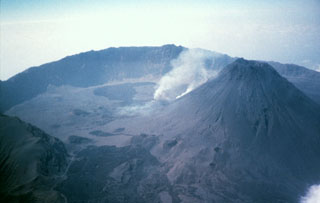Report on Fogo (Cabo Verde) — 7 January-13 January 2015
Smithsonian Institution / US Geological Survey
Weekly Volcanic Activity Report, 7 January-13 January 2015
Managing Editor: Sally Sennert.
Please cite this report as:
Global Volcanism Program, 2015. Report on Fogo (Cabo Verde) (Sennert, S, ed.). Weekly Volcanic Activity Report, 7 January-13 January 2015. Smithsonian Institution and US Geological Survey.
Fogo
Cabo Verde
14.95°N, 24.35°W; summit elev. 2829 m
All times are local (unless otherwise noted)
The Observatório Vulcanológico de Cabo Verde (OVCV) reported that on 8 January the eruption at Fogo decreased in intensity; a small light-colored gas plume rose at most 100 m from the craters. Some explosions, following banging noises, were felt in areas 1 km away. Periodic explosions continued the next day and at 1530 a dark gas-and-ash plume rose 1.2 km and drifted SE. On 10 January light-colored, dense plumes rose at 800-1,200 m. Explosions on 11 January produced light-colored gas plumes that rose as high as1.5 km. On 12 January gas-and-ash plumes rose 800-1,000 m. In the afternoon a strong explosion was followed by smaller explosions and accompanying crashing noises that lasted for 2 hours. A very dense and dark-gray ash plume rose 2 km and drifted E, and was observed by people in S Philip and other parts of the island. At 1900 tephra was ejected 50 m above the crater. The lava-flow fronts to the N and S of Ilhéu de Losna were stagnant, while a few outbreaks were observed in Portela and Bangaeira.
Geological Summary. The island of Fogo consists of a single massive stratovolcano that is the most prominent of the Cape Verde Islands. The roughly circular 25-km-wide island is truncated by a large 9-km-wide caldera that is breached to the east and has a headwall 1 km high. The caldera is located asymmetrically NE of the center of the island and was formed as a result of massive lateral collapse of the older Monte Armarelo edifice. A very youthful steep-sided central cone, Pico, rises more than 1 km above the caldera floor to about 100 m above the rim. Pico, which is capped by a 500-m-wide, 150-m-deep summit crater, was apparently in almost continuous activity from the time of Portuguese settlement in 1500 CE until around 1760. Later lava flows, some from vents on the caldera floor, reached the eastern coast below the breached caldera.
Source: Universidade of Cabo Verde

